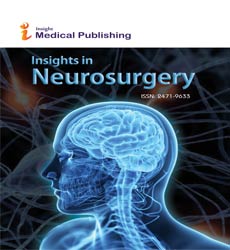Abstract
Neurology Congress 2018: Neuroimaging markers for vascular dementia after ischemic stroke - Neli Petrova - Clinic of Neurology
Aim: The objectives of this examination are to assess the deferred changes in cognizance in post stroke patients and their relationship to the neuroimaging markers estimated during the intense post stroke stage. Poststroke subjective weakness is visit. There are, in any case, barely any longitudinal examinations taking a gander at conceded changes in insight, and farsighted estimations of neuropsychological and neuroradiological markers.
Methods: Eighty-five first-historically speaking stroke inpatients (normal age 65.6±5.6) without past intellectual grumblings were tentatively evaluated with a thorough neuropsychological battery at 5-th day, 1-st, 6-th, 12-th, and 24-th month. Remembered for this examination were sequential inpatients with a first-since forever ischemic cerebral stroke, matured 50–80 years, inside 3 days of stroke beginning. Patients were enlisted from the serious stroke unit of the Clinic of Neurology, Ruse, Bulgaria. Stroke was described as serious start of focal neurological insufficiencies inferable from cerebrovascular affliction and recorded by electronic tomography (CT).
Results: A noncontract CT mind check assessment was done for all patients on admission to the emergency clinic and for 22 patients - at the 24-th month. Changes in the basal ganglia injuries, profound white issue and hippocampal decay were tried and analyzed. The outcomes plainly demonstrated hippocampal decay as an entirely steady indicator of intellectual impedance in practically all measures. Basal ganglia sores were significant for official brokenness and consideration. Then again, Medial Temporal Lobe (MTL) decay demonstrated high effect on the exhibition during consideration/official tests, even 2 years after stroke. What's more, the MTL decay expanded altogether in that time contrasted and the gauge. Psychological impedance after ischaemic stroke injury is basic in various populaces. In spite of the fact that dementia after stroke is a clinical element, current neuroimaging and obsessive examinations propose that larger part of more established age-related dementia after stroke can be classed as VaD. Rising little vessel infection related hereditary qualities, serious WM changes and average transient projection decay are significant highlights in the improvement of dementia after stroke injury. The entrenched connection between vascular hazard elements and dementia gives a basis to the execution of mediations. Control of vascular ailment hazard and avoidance of repetitive strokes are clearly key to decreasing the weight of psychological decay and dementia after stroke.
Conclusion: Cognitive impairments are common after stroke. These results highlight the important role of the initial assessment of MTL atrophy. In our study the hippocampal atrophy is the strongest predictor of cognitive impairment and dementia outcome, even in post stroke patients. Official working deficiency seems to have a prescient force for psychological disability movement. The examination recommends that IST as a screening test can possibly be a dependable and speedy apparatus for Poststroke subjective debilitation assessment and postponed psychological and neurological result. Hippocampal atrophy was the strongest witch for cognitive impairment outcome, even in post stroke cognitive impairment. The findings may set the stage for better post stroke management.
Recent Publications:
1. Petrova N. (2012) Evaluation of cognitive function and risk factors in the first 6 months after ischemic stroke. 21 European Stroke Conference, Lisboa, 2012. E-book; 392-393.
2. N. Petrova, S. ÃÆÃÂÃâà âÃÆÃÂÃâõhrabian, M. Raycheva, L. Traykov. (2014) Homocysteine and post-stroke cognitive deterioration in Bulgarian patients. Medical review. Vol. 50, 2014, ÃÆâÃâââ¬Å¾Ãâââ¬â 4; 39-44.
3. Mehrabian S., Raycheva M., Petrova N., Janian A., Traykov L. (2015) Neuropsychological and neuroimaging markers in prediction of cognitive impairment after ischemic stroke: a prospective follow-up study. Neuropsychiatric Disease and Treatment. ISSN: 1311-8641, 2015:11, 2711–2719.
4.Sokolov Ts, Manukova A, Karakoleva S, Valentinov B, Petrova N. (2017) Analysis of the results of applying the method platelet-rich plasma (PRP) for the treatment of problematic skin wounds. Journal of IMAB, ISSN: 1312-773X; 2017 Jan-Mar; 23(1):1460-1465.
5.Petrova N. (2016) Poststroke cognitive impairment in Bulgarian patients: prospective follow-up study. 23ÃÆà  Ãâó ÃÆÃÂÃâé .Multidisciplinary International Neuroscience and Biological Psychiatry Conference “Stress and Behavior”, St. Petersburg, 2016. Stress, Brain and Behavior. ISSN: 2374-3565. Vol. 5, 2016, 1-52.
Author(s):
Neli Petrova
Abstract | PDF
Share this

Google scholar citation report
Citations : 31
Insights in Neurosurgery received 31 citations as per google scholar report
Abstracted/Indexed in
- Google Scholar
- Directory of Research Journal Indexing (DRJI)
- WorldCat
- Secret Search Engine Labs
Open Access Journals
- Aquaculture & Veterinary Science
- Chemistry & Chemical Sciences
- Clinical Sciences
- Engineering
- General Science
- Genetics & Molecular Biology
- Health Care & Nursing
- Immunology & Microbiology
- Materials Science
- Mathematics & Physics
- Medical Sciences
- Neurology & Psychiatry
- Oncology & Cancer Science
- Pharmaceutical Sciences
